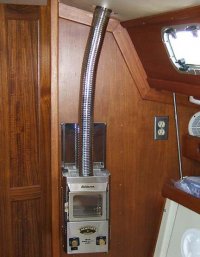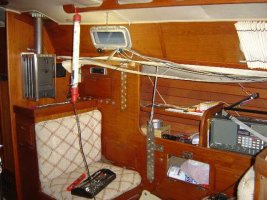More thoughts
More great input, thanks. I went to the Scanmarine website and the unit looks good. Twenty-two pounds for the Ardic is kind of scary, but it would help me balance out my port list. I am sticking with the Espar though. One track at a time. Just how well was your boat insulated during that single-digit weather?
I have to make a decision soon (if I want a post-Christmas shakedown cruise) about two quite different systems that I have been quoted. I've spent time at the distributor and called them for some system and options clarification. And then well over an hour on the phone with each installation company discussing (and sometimes changing) the details of their quotes. I am quite satisfied with the integrity of each, and with their committment to producing satisfied customers. Their opinions and experience don't always agree, so I'll lay out a few items and ask you to comment on your experience or hearsay.
Intended usage range - Pacific NW or West Coast - year round cruising. Summer to Alaska via the Inside Passage - someday. I want to be able to be away from services (fuel, water) for at least a week at a time - 2 weeks in summer.
Same-same in the two systems: Two cabin heat exchangers, one aft under the cabin steps and above the top of the engine, one at midship, floor-level under the aft stbd. settee seat. Domestic water heating.
Hydronic 10 has 1 year or 1000 hour warranty, the Hydronic 5 has a 2 year or 2000 hour warranty. I just noticed this last night in the distributor catalog after hanging up with the "10" people. Didn't get a chance to ask him about that - perhaps a good question for the distributor. The "10" people emphasized satisfactory heating performance. The "5" people emphasize reliable, low maintenance systems that do the job. The distributor sides with the "10" people, by the way.
Lots of anecdotal customer evidence from the "5" people about the suitability of the smaller unit, even in boats up to ~42 feet, supported by your opinions in earlier replies, on air systems. With our two-heater plus domestic water needs, the smaller unit seems like an adequate choice. The big debate - will the "10" burner "coke up" faster, if it is loafing much of the time, than the "5" which should spend more of it's lifetime running on Hi?
The domestic water option I settled on with the "5" would add a pump to circulate the engine coolant through an added coolant-to-coolant heat exchanger. This limits the draw off of BTUs from the cabin, but extends the time to heat my 12 gallons. The plan is to also heat the engine block rather than put any more time & $$ into plumbing around the engine. Engine waste heat would still heat water while motoring. The "10" system would eliminate engine waste heat to domestic water by putting the Espar coolant through the water heater. Only way to heat the domestic water away from 120 VAC is with the Espar. Eliminates a c-c heat exchanger. Good way to ensure we use the thing all year round. Adds hours against that 1000 hour warranty.
Final differences: "5" insists on dip tube in fuel tank, "10" likes to tap into the engine fuel system after the first filter. "Never" had a problem with it. I keep the boat in the mouth of a river. I am more worried about the engine quitting than not being able to run the heater on the last dregs of the fuel tank.
With the "5" I'm probably stuck with the two cabin heat exchanger system. With the "10" I could easily expand to a third cabin heater in the future.
The "5" would be installed in the stern lazarette, up high and out of the way. A bit problematic for installation and servicing, maybe. Flex hose for the exhaust. The "10" would be way forward in the starboard laz. and would take up about half a cubic ft. of storage. It would be enclosed somehow to keep stuff away from the hot parts. On the "10" they may recommend a hard exhaust system - add $ for welding/bending one up.
Price differential - mostly parts. The total on the "10" with the special pump w/check valve on the fuel system is $2,200 more than the "5"
I appreciate your input on this. Not an easy decsion. I've learned a lot from your experience and from talking to the companies. Thanks!




